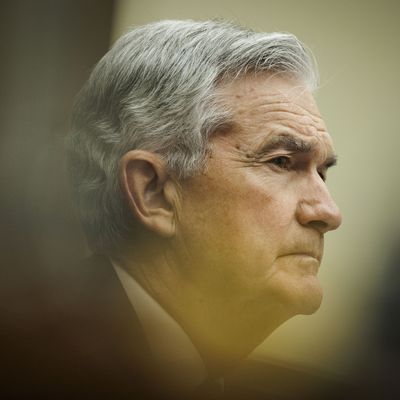
In March, before the Federal Reserve raised interest rates to a decade-plus high, the central bank’s administrators were presented with a staff report predicting that the coming year would be a bleak one for the economy. By the end of 2023, the Fed staff report said, it was likely the U.S. would be in a “mild recession,” with higher unemployment coming — and the situation not really getting much better until 2025, according to minutes of the meeting released Wednesday.
By then, the economy was already starting to show signs of strain under the rapid hiking regime that Fed chair Jerome Powell had led. The avatar for all that was wrong then was Silicon Valley Bank, a large and sophisticated institution that nevertheless imploded amid fears about how the swift rise in interest rates had affected the company. Those fears extended to many other regional banks and caused a period of chaos and instability in the banking system. Still, the Fed was unmoved by the forecast and decided once again to make borrowing more expensive in a bid to lower the inflation rate. In May, it’ll probably do it again, with the market seeing another quarter-point rise. No one really knows if there will be a recession later this year or not, but it’s clear that the possibility of one is looming, and the ways for the Fed to maneuver away from it are getting fewer.
There’s also a not-entirely serious indicator for recessions based on the opposite of whatever you see on magazine covers, particularly those of The Economist. The idea is that, by the time you’re likely to see headlines about the state of the economy — good or bad — while you’re looking for something to read at an airport, it’s already too late, and the bottom has fallen out. This idea has been around long enough that the editors of The Economist bravely did a story about it a few years ago, finding that, well, it isn’t exactly wrong. And this most recent cover — it’s a doozy:
With all this in mind, the bottom line is that a lot of what we tend to think of as “the economy” looks bad right now — or at least vulnerable.
Probably the biggest area of concern at the moment is the $1 trillion commercial real-estate market. In New York, the office-vacancy rate has actually increased from two years ago, according to real-estate firm JLL, and it’s likely to get worse, since at least half of most offices that are leased are sitting empty, according to Kastle Systems, which tracks employees badging in and out. This sure looks like a slow-motion disaster, a problem that began more than three years ago when everyone with a white-collar job first installed Zoom on their laptop to wait out the coronavirus. Even the biggest, most powerful companies in the world are still struggling to bring in their top executives every day. It’s not just that the people who make salads and shine shoes have fewer customers, as New York City mayor Eric Adams has said. The value of office space comes, in part, from jobs that require people to go there — a kind of built-in demand. When loans start souring, when real-estate companies can no longer pay for their leases, that’s when you can get contagion — the threat of a domino effect, brought on by broken banks and tougher lending standards. When banks are forced to get cautious, that means they make fewer loans, cutting off a spigot of money to the businesses that need that cash, and that pessimism can generally spread through the rest of the economy.
There’s a growing awareness in corporate America, abstract but real, that if things were going to go back to the way they were before the pandemic, they would have done so by now. And so the commercial real-estate problem looks like it’s only going to get harder. In 2025, some $1.5 trillion in office-space debt comes up for refinancing, with values of these properties poised to fall by some 40 percent, according to Bloomberg. This is where the banks come in. SVB’s collapse was a shock, but the demise of Signature Bank, a New York office-space lender, is arguably the real harbinger of where things are going. “The more problematic issue will be that most of the loans will have to be reset at different rates,” Ferenc Sanderson, an independent hedge-fund consultant, told me. “Higher rates means that some of the property owners are more likely to step away, which means that banks will be holding the bag on increasingly bad debt.” In turn, he said, those banks will be less likely to lend out more money to other businesses, if they survive at all.
Over at Bloomberg, Joe Wiesenthal pointed out that the problems we’re facing now are something of a reverse image of what happened during the financial crisis — it’s office space, not homes, that are in trouble; small banks, not big ones, are the weak link. And this makes sense. Wall Street reforms, as well as the general regulatory zeal that came with it, were focused on those things, and those measures were generally effective. But what do you do now? Office space hardly had casinolike risks prior to 2020, and there’s no telling how work is going to look in the decades to come. Right now, any worker who doesn’t have to go back into the office probably won’t — making the office space allotted for that person all the less valuable. That value is reflected in loans and securities held by many American banks, particularly smaller ones. And it’s not quite clear what there is to be done about all that.






























